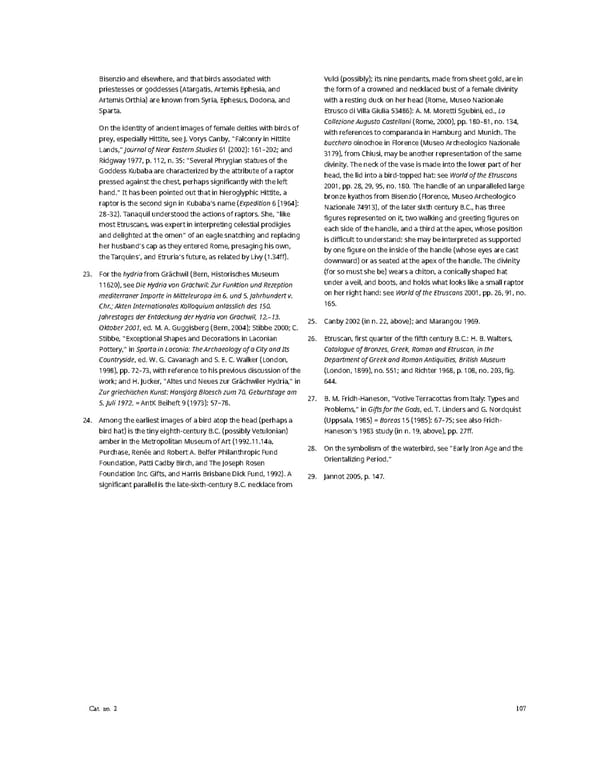Bisenzio and elsewhere, and that birds associated with Vulci (possibly); its nine pendants, made from sheet gold, are in priestesses or goddesses (Atargatis, Artemis Ephesia, and the form of a crowned and necklaced bust of a female divinity Artemis Orthia) are known from Syria, Ephesus, Dodona, and with a resting duck on her head (Rome, Museo Nazionale Sparta. Etrusco di Villa Giulia 53486): A. M. Moretti Sgubini, ed., La On the identity of ancient images of female deities with birds of Collezione Augusto Castellani (Rome, 2000), pp. 180–81, no. 134, prey, especially Hittite, see J. Vorys Canby, “Falconry in Hittite with references to comparanda in Hamburg and Munich. The Lands,” Journal of Near Eastern Studies 61 (2002): 161–202; and bucchero oinochoe in Florence (Museo Archeologico Nazionale Ridgway 1977, p. 112, n. 35: “Several Phrygian statues of the 3179), from Chiusi, may be another representation of the same Goddess Kubaba are characterized by the attribute of a raptor divinity. The neck of the vase is made into the lower part of her pressed against the chest, perhaps significantly with the left head, the lid into a bird-topped hat: see World of the Etruscans hand.” It has been pointed out that in hieroglyphic Hittite, a 2001, pp. 28, 29, 95, no. 180. The handle of an unparalleled large raptor is the second sign in Kubaba’s name (Expedition 6 [1964]: bronze kyathos from Bisenzio (Florence, Museo Archeologico 28–32). Tanaquil understood the actions of raptors. She, “like Nazionale 74913), of the later sixth century B.C., has three most Etruscans, was expert in interpreting celestial prodigies figures represented on it, two walking and greeting figures on and delighted at the omen” of an eagle snatching and replacing each side of the handle, and a third at the apex, whose position her husband’s cap as they entered Rome, presaging his own, is difficult to understand: she may be interpreted as supported the Tarquins’, and Etruria’s future, as related by Livy (1.34ff). by one figure on the inside of the handle (whose eyes are cast downward) or as seated at the apex of the handle. The divinity 23. For the hydria from Grächwil (Bern, Historisches Museum (for so must she be) wears a chiton, a conically shaped hat 11620), see Die Hydria von Grächwil: Zur Funktion und Rezeption under a veil, and boots, and holds what looks like a small raptor mediterraner Importe in Mitteleuropa im 6. und 5. Jahrhundert v. on her right hand: see World of the Etruscans 2001, pp. 26, 91, no. Chr.; Akten Internationales Kolloquium anlässlich des 150. 165. Jahrestages der Entdeckung der Hydria von Grächwil, 12.–13. 25. Canby 2002 (in n. 22, above); and Marangou 1969. Oktober 2001, ed. M. A. Guggisberg (Bern, 2004); Stibbe 2000; C. Stibbe, “Exceptional Shapes and Decorations in Laconian 26. Etruscan, first quarter of the fifth century B.C.: H. B. Walters, Pottery,” in Sparta in Laconia: The Archaeology of a City and Its Catalogue of Bronzes, Greek, Roman and Etruscan, in the Countryside, ed. W. G. Cavanagh and S. E. C. Walker (London, Department of Greek and Roman Antiquities, British Museum 1998), pp. 72–73, with reference to his previous discussion of the (London, 1899), no. 551; and Richter 1968, p. 108, no. 203, fig. work; and H. Jucker, “Altes und Neues zur Grächwiler Hydria,” in 644. Zur griechischen Kunst: Hansjörg Bloesch zum 70. Geburtstage am 27. B. M. Fridh-Haneson, “Votive Terracottas from Italy: Types and 5. Juli 1972. = AntK Beiheft 9 (1973): 57–78. Problems,” in Gifts for the Gods, ed. T. Linders and G. Nordquist 24. Among the earliest images of a bird atop the head (perhaps a (Uppsala, 1985) = Boreas 15 (1985): 67–75; see also Fridh- bird hat) is the tiny eighth-century B.C. (possibly Vetulonian) Haneson’s 1983 study (in n. 19, above), pp. 27ff. amber in the Metropolitan Museum of Art (1992.11.14a, 28. On the symbolism of the waterbird, see “Early Iron Age and the Purchase, Renée and Robert A. Belfer Philanthropic Fund Orientalizing Period.” Foundation, Patti Cadby Birch, and The Joseph Rosen Foundation Inc. Gifts, and Harris Brisbane Dick Fund, 1992). A 29. Jannot 2005, p. 147. significant parallel is the late-sixth-century B.C. necklace from Cat. no. 2 107
 Ancient Carved Ambers in the J. Paul Getty Museum Page 116 Page 118
Ancient Carved Ambers in the J. Paul Getty Museum Page 116 Page 118